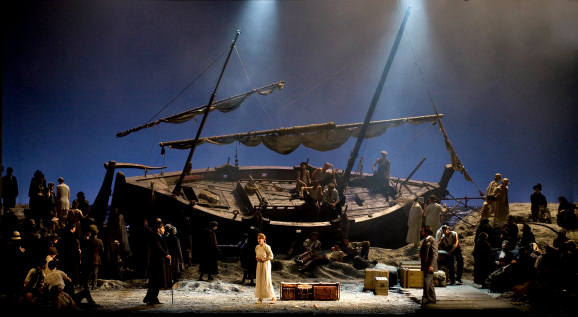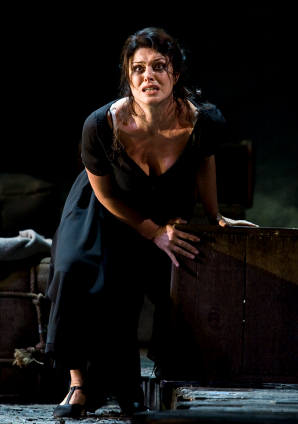Other Links
Editorial Board
- Editor - Bill Kenny
Founder - Len Mullenger
Google Site Search
SEEN
AND HEARD INTERNATIONAL OPERA REVIEW
Cherubini, Medea: Soloists,
Orchestra and Chorus Teatro Regio di Torino. Conductor: Evelino Pidó.
Teatro Regio di Torino. 9.10.2008 (JMI)
In Turin, Ana Caterina Antonnacci was once
again sang the title
role, as she had done a few years back in
Toulouse. Without a doubt she is one of the few singer-actresses
able to do justice to the character and is in fact probably the
best today in the role. Her Medea was very convincing, but I found
her, as happened in Toulouse, lacking a certain viscerality. Hers
is a young and beautiful Medea who never loses her composure. With a
far less rich voice, Denia Mazzola in Montpellier left the audience
breathless, such was her strength and conviction. Antonacci is
convincing of course but she does not quite enrapture, although her
voice has a particularly beautiful middle range.
New Production
Director: Hugo de Ana
Sets and Costumes: Hugo de Ana
Lighting: Pascal Merat
Cast:
Medea: Anna Caterina Antonacci
Giasone: Giuseppe Filianoti
Glauce: Cinzla Forte
Neris:
Sara Mingardo
Creonte: Giovanni Battista Parodi

It is
curious that Medea, or better Medée, was premiered
in Paris and in French yet whenever I have had the opportunity to
see it, whether in France or Italy, it has been always in the
Italian version. The origin of today’s most familiar version was
in Germany, where in 1854 Fritz Lachner changed the opera’s
dialogues into recitatives; later Zangarini prepared an Italian text
for the premiere at La Scala in 1909. As I said already, this is
the version that Maria Callas chose to put the work into
the main operatic repertoire and it is ‘her’ Medea which
has been sung by most of the top ranking sopranos ever since.
Medea
is musically superior to most others written in the second half of
18th century (Mozart apart) and it calls attention
powerfully to the dominant role of the orchestra.. It succeeds of
course principally on the stature of the protagonist : either there
is an exceptional Medea or the opera loses much of its interest.
This is been the case ever since Callas and will continue to be.

Anna Caterina Antonacci
as Medea
Hugo de Ana’s production offers a timeless drama or, at least, this
is what he said in an interview. In fact, the costumes, except for
those for Medea and Neris, correspond the first two decades of the
1900s. In the same interview De Ana also says that Medea could be
set in any location, even on the Moon. With that in mind, he
decides to stage it on a rough beach. This is where Glauce and her
friends have their picnic and where the wedding banquet takes place,
after which we see a boat (The Argonauts?) aground on the beach.
Later the boat becomes Medea’s home. It’s more a serviceable
production than a truly bright idea.
Evelino Pidó gave a good reading of the opera, offering the
necessary dramatic intensity. He was very good in the purely
orchestral passages, particularly the overture. He drew a very good
performance from the Orchestra and Chorus of Turin’s Teatro Regio.
The result was good but perhaps even more
passion may be needed when conducting
this opera.
The rest of the cast is of a lesser importance in Medea.
Among them we had Giasone, interpreted by Giuseppe Filianoti. It was
something of a surprise to find him in this role, both because he is
usually the main character in the operas he sings and also because
Giasone requires a heavier voice than Filianoti’s. His voice keeps
its beautiful center and its slightly small upper register.
As the bereaved Neris, Sara Mingardo
sang her second act aria with sensitivity and great good and
Cinzia Forte was a more than adequate Glauce, although some
hardness in the higher notes. Giovanni Battista Parodi as Creonte
proved again that what he has gained in vocal volume he has lost
in quality. Not the best of changes. There was a full house with a
great success for Antonacci, and a nicely favourable response to
Evelino Pidó.
Jose M. Irurzun
Pictures: Ramella and Giannese © Fondazione Teatro Regio
di Torino
Back
to Top
Cumulative Index Page
